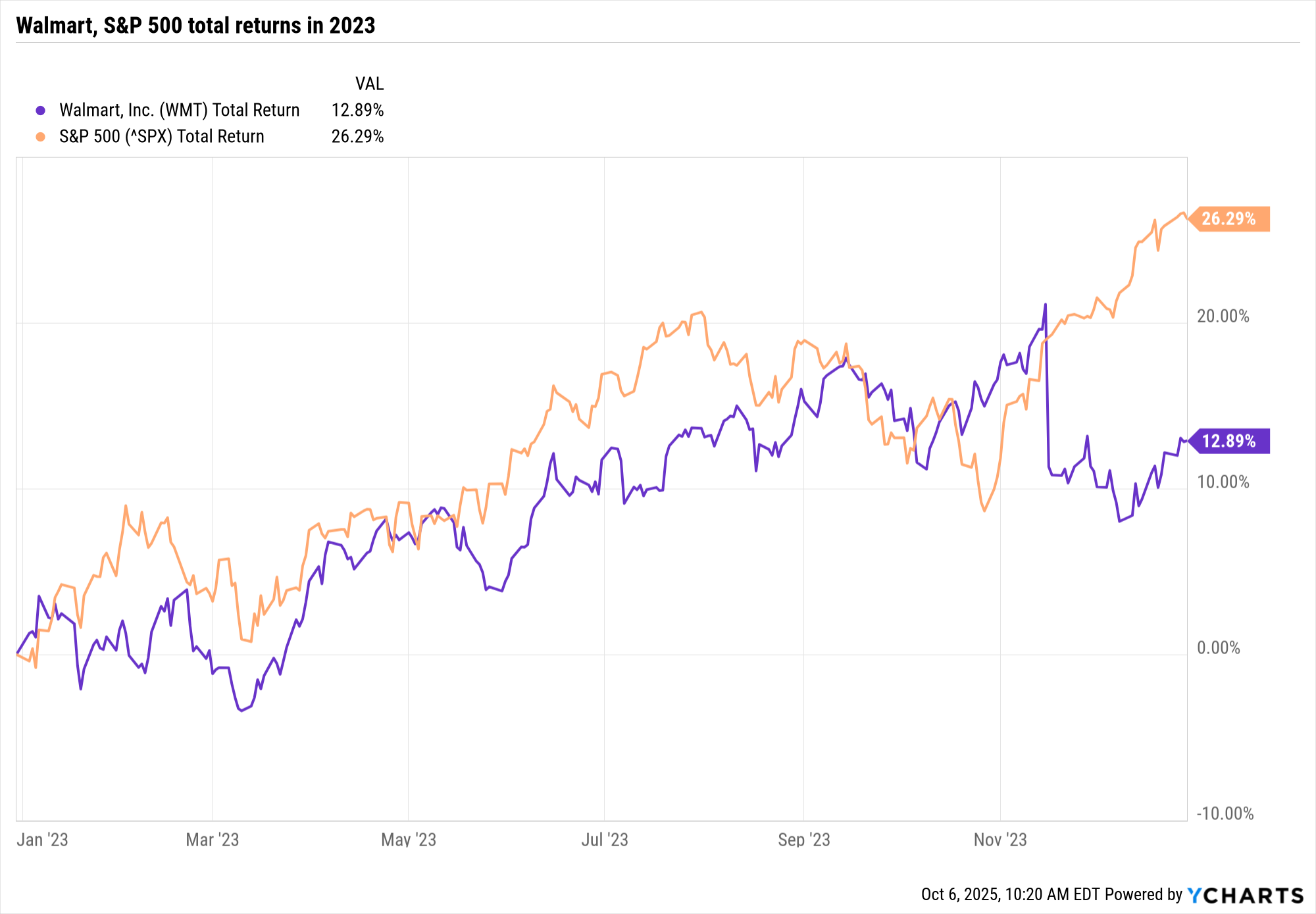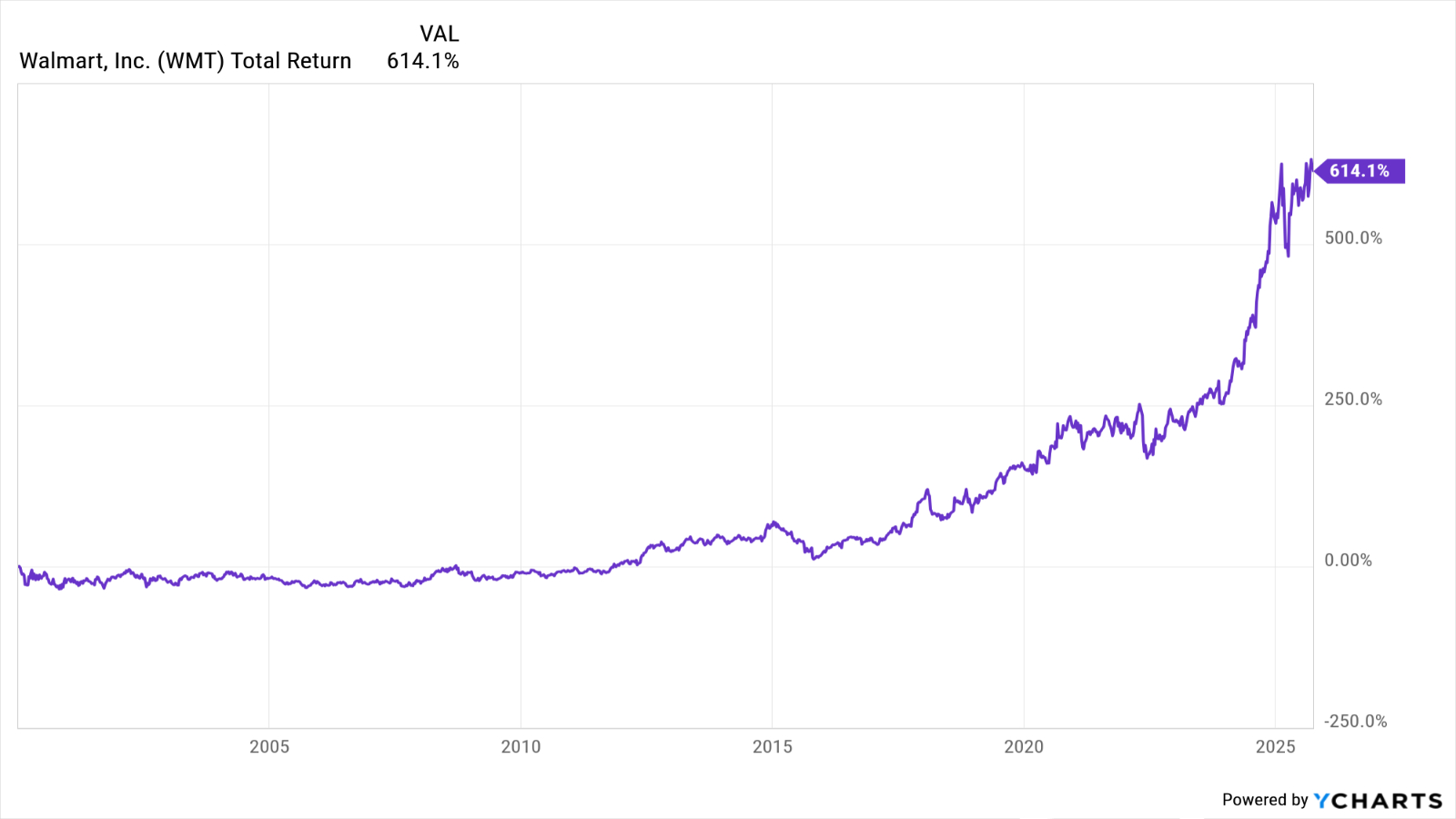If You'd Put $1,000 Into Walmart Stock 20 Years Ago, Here's What You'd Have Today
Walmart stock has beaten the broader market by a slim margin over the past couple of decades.



When it comes to blue chip stocks that pay dividends and play defense, Walmart's (WMT) reputation is pretty tough to beat.
Indeed, Walmart is indisputably one of the best dividend stocks for dependable dividend growth.
This member of the S&P 500 Dividend Aristocrats has increased its payout annually for more than half a century. For those reasons and more, Walmart ranks as one of analysts' top-ranked Dow Jones stocks.
From just $107.88 $24.99 for Kiplinger Personal Finance
Become a smarter, better informed investor. Subscribe from just $107.88 $24.99, plus get up to 4 Special Issues

Sign up for Kiplinger’s Free Newsletters
Profit and prosper with the best of expert advice on investing, taxes, retirement, personal finance and more - straight to your e-mail.
Profit and prosper with the best of expert advice - straight to your e-mail.
Walmart's defensive characteristics certainly came in handy in 2022, as you can see in the chart below.
The S&P 500 generated a total return (price change plus dividends) of -18.1%, a historically bad result.
On the other hand, Walmart's total return came to -0.5% – or essentially flat – to beat the broader market by more than 17 percentage points.

The other side of WMT's defensive coin can be seen in its performance during 2023's remarkable rally. While the S&P 500 returned more than 26%, Walmart returned less than 13%.

As for 2024, WMT beat the broader market by nearly 50 percentage points, helped by resiliency in the labor market and consumer spending.
Happily for long-term shareholders, WMT stock's outperformance over the past 52 weeks has helped it turn in market-beating returns on a 20-year basis.
That's a change in fortune. WMT stock was a long-time laggard following a torrid run in the 1990s, hurt by the market's preference for growth over value, as well as worries about the future of bricks-and-mortar retail.
The bottom line on Walmart stock
Walmart stock was actually one of the best stocks of the 30 years between 1990 and 2020, but as you can see in the chart below, WMT basically traded sideways for the first decade-plus of the 21st century.

Walmart shares went nowhere for a long time, but then that's not necessarily unusual given how far and fast they appreciated during the bubblicious 90s.
Between the beginning of 1997 and the end of 1999, WMT gained more than 500% on a price basis. The broader market didn't quite double over the same span.
Also weighing on WMT during the first decade of the new century was the threat from e-commerce.
Walmart responded by becoming the second-largest e-commerce retailer in the U.S. after Amazon.com (AMZN) – albeit a distant second. Walmart got serious about its digital strategy sometime around 2006, but it took a while for what was regarded as "show-me" story to ultimately prove successful.
Whatever the causes, that lost decade on Walmart's stock chart really hurts its long-term results. Over the past 20 years, WMT stock has generated an annualized total return of 12.5% vs 11% for the S&P 500.
And even then, that one percentage point of outperformance emerged only recently. To get a sense of what this sort of ride looks like on a stock chart, see the image below.

The chart illustrates the fact that if you invested $1,000 in Walmart stock 20 years ago, today it would be worth about $10,500. The same thousand bucks invested in an S&P 500 ETF would be worth about $8,000 today.
For its entire history as a publicly traded company, WMT's annualized total return beats the broader market by 2.5 percentage points.
More Stocks of the Past 20 Years
- If You'd Put $1,000 Into Nvidia Stock 20 Years Ago, Here's What You'd Have Today
- If You'd Put $1,000 Into Sherwin-Williams Stock 20 Years Ago, Here's What You'd Have Today
- If You'd Put $1,000 Into Berkshire Hathaway Stock 20 Years Ago, Here's What You'd Have Today
Profit and prosper with the best of Kiplinger's advice on investing, taxes, retirement, personal finance and much more. Delivered daily. Enter your email in the box and click Sign Me Up.

Dan Burrows is Kiplinger's senior investing writer, having joined the publication full time in 2016.
A long-time financial journalist, Dan is a veteran of MarketWatch, CBS MoneyWatch, SmartMoney, InvestorPlace, DailyFinance and other tier 1 national publications. He has written for The Wall Street Journal, Bloomberg and Consumer Reports and his stories have appeared in the New York Daily News, the San Jose Mercury News and Investor's Business Daily, among many other outlets. As a senior writer at AOL's DailyFinance, Dan reported market news from the floor of the New York Stock Exchange.
Once upon a time – before his days as a financial reporter and assistant financial editor at legendary fashion trade paper Women's Wear Daily – Dan worked for Spy magazine, scribbled away at Time Inc. and contributed to Maxim magazine back when lad mags were a thing. He's also written for Esquire magazine's Dubious Achievements Awards.
In his current role at Kiplinger, Dan writes about markets and macroeconomics.
Dan holds a bachelor's degree from Oberlin College and a master's degree from Columbia University.
Disclosure: Dan does not trade individual stocks or securities. He is eternally long the U.S equity market, primarily through tax-advantaged accounts.
-
 10 Cheapest Places to Live in Washington
10 Cheapest Places to Live in WashingtonProperty Tax Is Washington your go-to ski destination? These counties combine no income tax with the lowest property tax bills in the state.
-
 Healthy to 100: Secrets from Countries Where Retirees Age Best
Healthy to 100: Secrets from Countries Where Retirees Age BestLongevity is a team sport, according to author Ken Stern. Here's the secret sauce for living long, healthy lives from countries like Italy and Japan.
-
 My First $1 Million: Semiretired CPA, 68, San Francisco
My First $1 Million: Semiretired CPA, 68, San FranciscoEver wonder how someone who's made a million dollars or more did it? Kiplinger's My First $1 Million series uncovers the answers.
-
 6 Overlooked Areas That Can Make or Break Your Retirement, From a Retirement Adviser
6 Overlooked Areas That Can Make or Break Your Retirement, From a Retirement AdviserIf you're heading into retirement with scattered and uncertain plans, distilling them into these six areas can ensure you thrive in later life.
-
 I'm a Wealth Adviser: These Are the 7 Risks Your Retirement Plan Should Address
I'm a Wealth Adviser: These Are the 7 Risks Your Retirement Plan Should AddressYour retirement needs to be able to withstand several major threats, including inflation, longevity, long-term care costs, market swings and more.
-
 Stocks Struggle for Gains to Start 2026: Stock Market Today
Stocks Struggle for Gains to Start 2026: Stock Market TodayIt's not quite the end of the world as we know it, but Warren Buffett is no longer the CEO of Berkshire Hathaway.
-
 How New Investors Can Pick Their Perfect Portfolio, According to a Pro
How New Investors Can Pick Their Perfect Portfolio, According to a ProSee what Cullen Roche has to say about finding your perfect portfolio as a new investor and his two-word answer on where he thinks the stock market is headed in 2026.
-
 High-Net-Worth Retirees: Don't Overlook These Benefits of Social Security
High-Net-Worth Retirees: Don't Overlook These Benefits of Social SecurityWealthy retirees often overlook Social Security. But timed properly, it can drive tax efficiency, keep Medicare costs in check and strengthen your legacy.
-
 Do You Have an Insurance Coverage Gap for Your Valuables? You May Be Surprised to Learn You Do
Do You Have an Insurance Coverage Gap for Your Valuables? You May Be Surprised to Learn You DoStandard homeowners insurance usually has strict limits on high-value items, so you should formally "schedule" these valuable possessions with your insurer.
-
 If You'd Put $1,000 Into Lowe's Stock 20 Years Ago, Here's What You'd Have Today
If You'd Put $1,000 Into Lowe's Stock 20 Years Ago, Here's What You'd Have TodayLowe's stock has delivered disappointing returns recently, but it's been a great holding for truly patient investors.
-
 Don't Trade After-Hours Without Reading This
Don't Trade After-Hours Without Reading ThisAre you a night owl or an early bird with a yen for active trading? Before you transact after-hours, consider these tips and potential traps.